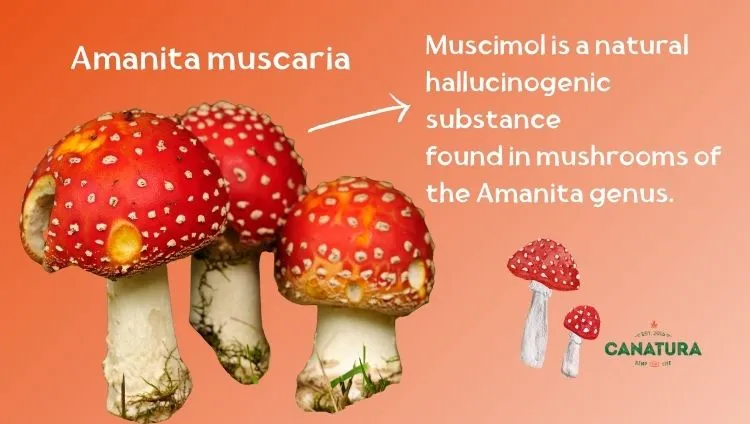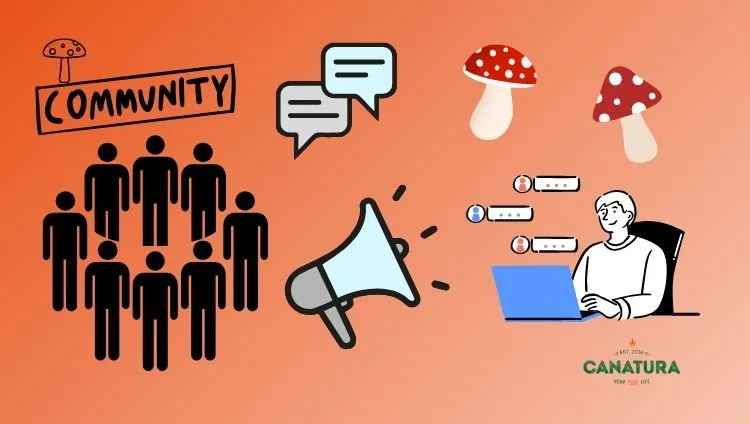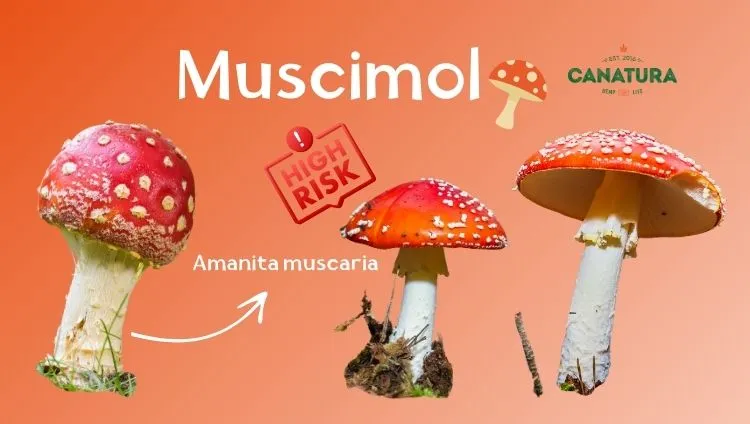What is muscimol? Effects, user experiences, risks and overdose (poisoning)
- What is muscimol?
- How does it work?
- User experiences and community
- Risks, overdose and poisoning
- Conclusion
- FAQ
What is muscimol?
Muscimol is a natural hallucinogenic substance from the isoxazole group, which occurs naturally in mushrooms of the Amanita genus, primarily in the fly agaric (Amanita muscaria) and the related panther cap.
Chemically, it is a neurotoxin that acts as a powerful depressant of the central nervous system. Fresh fly agaric mushrooms mainly contain ibotenic acid, which is partially converted to muscimol during drying or heating (this reduces the acute toxicity of the mushroom, but the psychoactive effects remain).
Historically, muscimol, or rather the consumption of fly agaric, was used, for example, in traditional ceremonies in Siberia as an entheogen – an intoxicant that induces an altered state of consciousness.
Western science has been studying muscimol since the 1960s, when it was isolated and its mechanism of action described. Despite this, it still has the status of a mysterious substance – a potent hallucinogen and toxin that has only gained wider attention in recent years thanks to a new wave of interest in “legal psychedelics“.

How does it work?
Muscimol acts in the brain by mimicking the neurotransmitter GABA – it binds to GABA-A receptors on neurons, thereby inhibiting (suppressing) neuronal activity.
There are several types of receptors in the brain that respond to GABA γ-aminobutyric acid (the main inhibitory neurotransmitter). The two most common types are:
- GABA-A receptors: Ionotropic (form an ion channel), their activation leads to the immediate entry of chloride ions into the neuron → rapid inhibition (suppression of activity).
- GABA-B receptors: metabotropic (work via G-proteins and secondary messengers), act more slowly and for longer.
This different pharmacology significantly distinguishes muscimol from common hallucinogens such as psilocybin or LSD, which act via serotonin receptors.
Muscimol is therefore more of a sedative-hypnotic hallucinogen than a classic “trip” with pronounced sensory hallucinations: it induces a state of sedation, altered consciousness and dreamlike visions.
Muscimol effects
- Psychic and sensory effects: Muscimol significantly alters perception. Users describe feelings of lightness or detachment from the body, heightened sensory sensitivity (e.g., sharper hearing or vision), distortion of space and time, and often vivid dreamlike visions.
- Colourful or kaleidoscopic hallucinations: These tend to be short-lived and intermingle with phases of confusion and numbness – they differ from those induced by LSD.
Physical effects (depressant symptoms) include:
- Significant drowsiness
- Lethargy
- Reduced muscle tension
- Slightly clouded consciousness, similar to that caused by sedatives or high alcohol intoxication
The effects also depend on the size of the dose:
- Doses estimated at up to ~10 mg of muscimol:
- A slight “intoxication” similar to alcohol (relaxation, fewer inhibitions)
- Feelings of cheerfulness, laughter or elevated mood
- Sometimes a feeling of “lightness of body” or dreamlike perception
- Medium doses (10–15 mg):
- Significant impairment of attention, thinking and speech
- Problems with orientation in time and space
- Illusions and strange phenomena such as “echoes” of sounds or déjà vu
- High doses:
- Delirium: vivid hallucinations and significant changes in consciousness
- Severe confusion
- Restlessness
- Muscle twitching and uncoordinated movements
Muscimol often causes amnesia, especially at higher doses, so that the user does not remember periods of intoxication after the effects have worn off, which differs from serotonergic hallucinogens.
Side effects
Common side effects include:
- Nausea and vomiting, which occur especially in the initial phase, due to the presence of irritating ibotenic acid in the mushroom.
- Headache
- Dizziness
- Balance disorders (ataxia)
- Blurred vision
Studies and user surveys show interesting differences between the sexes. According to one analysis, women most often reported headaches after taking muscimol, while men more often reported gastrointestinal problems (nausea, vomiting, abdominal cramps) and severe drowsiness.
The effects mentioned vary from person to person; some people describe the experience as relatively peaceful with minimal discomfort, while others experience unpleasant physical symptoms, a so-called bad trip associated with anxiety and confusion.
After ingesting muscimol (e.g. in the form of a decoction of fly agaric or swallowed extract), the first effects usually appear within 30 to 90 minutes. The effect peaks in 2–3 hours and the total duration of intoxication is usually around 6–8 hours (this may vary from person to person).
The course is usually two-phase: after an initial stimulation phase, which may include euphoria or restlessness, there is a strong sedation, drowsiness and a dreamlike state, which can turn into a short “trance-like sleep” with vivid dreams or hallucinations.
It is reported that muscimol does not induce tolerance, so repeated use in quick succession does not reduce the effect as significantly as with LSD or psilocybin.
However, the line between a pleasant experience and unpleasant intoxication is very thin.
Due to the sedative effect of muscimol, there is a risk that the user will fall into a semi-sleep in the deeper stages of intoxication, experience uncontrollable dreams and lose their balance, significantly increasing the risk of injury or accident under the influence.
Overall, the effects of muscimol are individual and difficult to predict, even more so than with “classic” hallucinogens. It depends not only on the exact dose and composition of the mushroom, but also on the mental and physical condition of the consumer and the environment in which it is used.
User experiences and community
There is an active community of people interested in Amanita muscaria and muscimol on the internet. For example, Reddit has a discussion forum called r/AmanitaMuscaria with thousands of members, where users share their experiences, so-called trip reports, recipes for preparing fly agaric mushrooms, and advice for newcomers.
An analysis of nearly 1,000 posts and more than 9,500 comments from this subreddit forum revealed that user experiences are very diverse, but surprisingly mostly positive.

According to the study, most participants reported experiencing more positive than negative effects, with any unpleasant side effects usually mild and self-limiting.
Many describe the muscimol state as euphoric, introspective, and spiritually interesting, but less intense than an LSD trip. There are frequent mentions of vivid dreams and a feeling of purification or relaxation upon waking.
Negative experiences mainly revolve around nausea, vomiting, fatigue or headaches that occurred at the beginning. Only a small proportion of users reported outright bad trips with anxiety or panic.
However, experts warn against overly idealising muscimol on social media. The online community may suffer from selection bias, as it is mainly those who have had relatively good experiences who speak up, while those who ended up in hospital do not contribute to the forum.
Studies also point out that there is a lot of misleading information circulating on Reddit and Facebook that downplays the toxicity of fly agaric.
For example, there are instructions on “safe preparation” or statements such as that if the mushroom grows in a clean environment, it is not poisonous, which is definitely not based on reality. Users reassure each other about the legality and availability of muscimol, which may encourage others to try it.
Anyone who draws knowledge from online forums should therefore maintain a healthy scepticism. User reports can be valuable for understanding experiences, but they are no substitute for scientific knowledge about the risks.
In general, experiences with psychedelic substances are highly subjective, and what may be a pleasant dreamy evening for one person may end in another running around outside in confusion and calling an ambulance. Especially with the fly agaric, which can also cause poisoning, internet recommendations should be taken with a grain of salt.
Risks, overdose and poisoning
Muscimol is a toxic substance that can cause poisoning if used improperly.
The fly agaric is classified as a poisonous mushroom in mycology (although not deadly), and its consumption can lead to serious health complications. However, fatal poisoning with muscimol is very rare (with medical care, most patients survive intoxication).
Although there have been historical reports of deaths after ingesting large quantities of fly agaric mushrooms, modern medicine can save even severely poisoned patients in most situations.
Nevertheless, the toxicity threshold is very treacherous. In humans, the estimated median toxic dose (TD_50) of muscimol is around 0.65 mg per kilogram of body weight, and the lethal dose (LD_50) is approximately 8 mg/kg (data based on experiments on mice).
- TD_50 (Toxic Dose) = toxic dose for 50% of the population (adverse effect)
- LD_50 (Lethal Dose) = lethal dose for 50% of the population
This is experimental data (mostly on animals, typically mice or rats).
For an adult weighing 70 kg, a life-threatening amount would theoretically be 30–60 mg of pure muscimol.
For comparison, one dried fly agaric mushroom may contain about 6–10 mg of muscimol, but the actual content can vary significantly from piece to piece.
However, the risks of muscimol lie not only in its toxicity, but also in the behaviour of the intoxicated person. Accidents or injuries may occur during delirium. It is also dangerous to combine it with alcohol, sedatives or opiates, which together can cause fatal respiratory and cardiac depression.
Another serious risk is confusion, as the fly agaric can be mistaken for edible species of mushrooms, especially after rain, when its red cap is washed away.
Symptoms of overdose (poisoning)
Symptoms of muscimol overdose usually appear within 2 hours of ingestion.
Symptoms of poisoning include:
- Severe nausea and vomiting
- Heavy sweating, salivation and tearing (muscimol also has partial cholinergic effects)
- Balance disorders, muscle twitching and cramps
- Extreme drowsiness to unconsciousness
- Alternating delirium (confusion, hallucinations) and deep sleep
- Respiratory depression (slowed breathing), in severe cases up to respiratory arrest
Medical records indicate that patients with severe poisoning often experience:
- Dilated pupils
- Irregular heartbeat
- Coma-like state
- Amnesia: upon awakening, the patient does not remember the course of intoxication
Treatment of poisoning is only supportive, including monitoring of vital functions, ensuring breathing and circulation, and, if necessary, administering benzodiazepines to calm seizures or restlessness. There is no specific antidote (antibody or drug that directly neutralises the poison).
Clinical reports show that fatal cases are rare, but they do occur. Medical literature describes, for example, the death of a 44-year-old man as a result of severe poisoning by the panther cap mushroom (which contains the same toxins). The patient collapsed after ingesting a decoction of several caps and, despite the efforts of doctors, died of respiratory failure.
In general, however, most cases of poisoning end in survival. For example, in Lithuania in 2023, four men were hospitalised after consuming fly agaric mushrooms during their leisure time. Although they developed serious symptoms (tremors, breathing difficulties, paranoia), they recovered with supportive care and were discharged in good condition.
Conclusion
While in the past, the fly agaric was mainly depicted in fairy tales and illustrations as a poisonous mushroom 🍄, today one of its main active ingredients, muscimol, is the focus of attention of both experts and the general public as a legally available hallucinogen.
Although it may be tempting due to its reputation and easy availability, it must be approached with great caution. Scientific research is still in its infancy, and the only thing that is certain at this point is that the risks outweigh the potential benefits.
FAQ
Take a look at other questions that interest you most in relation to this topic.
1. Is muscimol legal?
The legal status of muscimol (and, by extension, the fly agaric mushroom) varies from country to country and mostly falls into a grey area between food legislation and the regulation of psychoactive substances.
Unlike psilocybin or THC, muscimol is not explicitly listed as a prohibited narcotic or psychotropic substance in many countries. Currently, even Europe does not have uniform regulations – at the EU level, muscimol is not listed as a controlled drug, so it falls under the jurisdiction of national laws.
- Czech Republic: In the Czech Republic, neither muscimol nor Amanita muscaria are listed as narcotic and psychotropic substances.
- Germany: The Betäubungsmittelgesetz (BtMG) does not list muscimol or ibotenic acid among prohibited substances.
- Netherlands: As of December 1, 2008, it was prohibited to sell both fresh and dried “paddo’s”, i.e., mushrooms containing psilocybin/psilocine.; possession of >0.5 g dried or >5 g fresh is a criminal offence.
- France: Amanita muscaria is not listed as a psychotropic or narcotic substance, but promotion may be regulated.
- Romania: Romanian legislation prohibits hallucinogenic mushrooms (e.g., psilocybe) in the sense of a general ban on use, trade, and possession.
- Spain: Amanita muscaria is not controlled as a narcotic substance. Sale as a food or supplement is restricted; there are warnings from AESAN.
- Sweden and Finland: Fly agaric mushrooms are not considered a drug, and their collection is legal (in Sweden, they are also traditionally used as fly traps – “flugsvamp”).
- Poland: Amanita muscaria is not on the list of narcotics, but its sale for human consumption is prohibited; it is sold as an “inedible collector’s item”.
- Australia: Muscimol is in the strictest category (Schedule 9), mushrooms are de facto illegal.
- Mexico, Thailand, Canada: No specific ban; fly agaric mushrooms are legal because the laws only mention substances such as psilocybin, not muscimol.
- United States: Muscimol is not a federally controlled substance in the US and possession of fly agaric mushrooms is legal, but their sale for human consumption is prohibited by the FDA (Food and Drug Administration); the exception is the state of Louisiana, where cultivation and sale are also prohibited (except for ornamental purposes).
The information is current as of September 3, 2025.
2. What are muscimol gummies and “magic muscimol gummies”?
Muscimol gummies, or jelly sweets, are a new trend in the psychoactive products market. These are so-called edibles – sweets infused with red fly agaric extract, which have appeared on the market, usually under the name “Magic muscimol gummies” or “Space Mushies” (space mushrooms).
These sweets are usually officially sold as collectibles or souvenirs.
3. What are the risks associated with muscimol gummies?
In the Czech Republic, the State Agricultural and Food Inspection Authority (SZPI) responded to the trend of these gummies by conducting targeted inspections in 2024 and discovering several such products on the market. The SZPI assessed these products as harmful to health and banned their sale; administrative proceedings were initiated against the sellers.
In Germany, muscimol was detected for the first time in August 2024 in confectionery imported from the Czech Republic, and in early September, the first patient had to be hospitalised after consuming these sweets.
In October 2024, Spain discovered an entire batch of products containing muscimol in a brick-and-mortar shop in Madrid; the products were confiscated and the authorities warned the public.
Between August and October 2024, six warnings were issued under the European Rapid Alert System for Food and Feed (RASFF) concerning the sale of food containing muscimol. One of them was directed at the Czech Republic, precisely because of a Czech e-shop.
In the US, several dozen cases of serious intoxication have been reported after consuming these sweets. For example, according to a report in the daily newspaper El País, the Diamond Shruumz brand product (jelly beans and chocolates containing muscimol) was linked to 175 cases of poisoning, 70 hospitalisations and 3 deaths.
Muscimol sweets pose a serious risk because their playful appearance hides a powerful hallucinogen in unpredictable amounts. Even when compared to LD_50 in mice, they are more toxic than fentanyl, PCP (phencyclidine) or cocaine.
Experts also point out that these are often illegally imported products, the quality and dosage of which cannot be controlled, which significantly increases the risk of poisoning.
4. Does muscimol have any potential benefits?
The therapeutic effects of muscimol have not been clinically proven, yet various alleged benefits have emerged, mainly based on user experience.
In online discussions, people report using it to relieve stress, anxiety, depressive moods, insomnia, or to alleviate chronic pain.
Analysis of the posts shows that men are more likely to seek psychological effects (sleep, mood), while women are more likely to seek physical relief (joint and muscle pain, skin problems). Some also mention microdosing for relaxation, meditation or vivid dreams – but these are purely subjective experiences.
Sales websites often vaguely refer to studies on psilocybin and suggest similar antidepressant or anxiolytic effects for muscimol.
However, experts warn that this is misleading marketing, as psilocybin activates serotonin receptors and has a proven antidepressant effect, while muscimol acts as a central nervous system depressant, similar to alcohol or benzodiazepines.
To date, there are no clinical studies confirming that muscimol helps with depression, anxiety or other mental disorders.
5. Does muscimol have therapeutic potential?
The therapeutic potential of muscimol has so far only been demonstrated in experimental conditions.
- Animal studies: Strong anticonvulsant effect (blocking epileptic seizures in mice) without significant toxicity.
- Analgesic effects: In combination with certain antidepressants (e.g. citalopram), it enhanced pain relief.
- Neuroprotection: Experiments suggest a protective effect on nerve cells during ischaemia and neurodegenerative processes.
- Limitations: All findings come from animal or cell culture research; muscimol has not been clinically tested in humans.
- Comparison: Psilocybin is already in clinical trials for depression, while muscimol remains in the realm of basic research and toxicology.
Sources:
- mdpi.com
- sciencedirect.com/science/article/pii/S0920121123000220
- pubmed.ncbi.nlm.nih.gov
- journals.vu.lt/AML/article/view/39781
- fda.gov/food/hfp-constituent-updates/fda-alerts-industry-and-consumers-about-use-amanita-muscaria-or-its-constituents-food
- today.ucsd.edu/story/unregulated-sales-of-a-toxic-and-hallucinogenic-mushroom-endanger-public-health
- szpi.gov.cz
- szpi.gov.cz/en/article/cafia-banned-products-with-hallucinogen-originating-from-fly-amanita
- szpi.gov.cz/clanek/potravinarska-inspekce-zjistila-dalsi-produkt-s-obsahem-muscimolu-halucinogenu-z-muchomurky-cervene
- english.elpais.com/health/2024-11-01/gummies-laced-with-natural-hallucinogens-put-europe-and-the-us-on-alert
- aliem.com/amct-toxicology-visual-pearls-mushroom-mania
- filstalexpress.de/freizeit/192357/gefaehrlicher-trend-pilzgift-muscimol-in-fruchtgummis-bvl-legt-aktuellen-bericht-zum-europaeischen-schnellwarnsystem-rasff-vor
- bvl.bund.de/SharedDocs/Pressemitteilungen/01_lebensmittel/2025/PM_RASFF-Meldungen-2024
- aesan.gob.es/AECOSAN/web/seguridad_alimentaria/alertas_alimentarias/2024_69.htm
- bfr.bund.de/en/notification/fly-agaric-poison-health-risks-of-fruit-gummies-containing-muscimol-children-are-particularly-at-risk/
Author: Patricie Mikolášová
Photo: AI
“All information provided on this website, as well as information provided through this website, is for educational purposes only. None of the information contained herein is intended to be a substitute for a medical diagnosis and should not be considered medical advice or recommended treatment. This website does not endorse, condones or advocate the licit or illicit use of narcotic drugs or psychotropic substances or the commission of any other illegal activity. For more information, please see our Disclaimer .”

